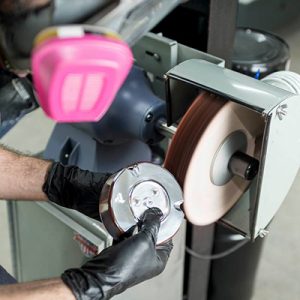Overload. Thinking readers wonder. What happens if due to laziness, these footers are used well beyond their weight rating? "Dawid seemed to think that changing our Viscorings was easy but I warn you, it gets a bit arduous when changing many because particularly the soft ones are super tacky. If you find yourself pushed for time, I suspect swapping just 4 for your sound|kaos sub will be the highest priority. It's fine using our footers over their weight limit on your Aurai speakers for example. What happens then is that an inner viscoelastic pad begins to compress to raise the spring rate. After a certain point, eventually the top and bottom portions will couple vertically but horizontally oriented isolation continues due to the ball bearings. Rather than ride in circular races like most designs, these bearings roll freely on flat hardened steel races. Viscoelastic buffers act as highly damped springs keeping the lower portion centered in response to vibrations. I included a hex wrench to remove the top and re-assemble. Here are some visual instructions to explain the process. When re-assembling, I wouldn't sweat getting each and every bolt to completely seat if pressed on time."

Underneath the loads. From my review of the Swiss sound|kaos DSUB 15, "whilst downfiring subs are the worst offenders—their woofer excursions duplicate the orientation of actual jackhammers—and despite stacked Ply's endless wood/glue layers, some of the very considerable forces generated by these two closely face-to-face 15" woofers leeched into our parquet floor even though the inherent cancellation of two equal but opposing forces makes for a surprisingly still cabinet. Though not suspended as upstairs but with the sub floor now on a solid concrete slab, the big heavy subwoofer still coupled to the floor for some structural amplification. With Jeffrey's footers, I'd have the same horizontal dissipation I already exploited with HifiStay's multi-layer rollerball footers plus proper vertical isolation. The Koreans blocked the energy transfer quite effectively and far better than Martin's more generic footers, just not entirely. I still had very mild 'knots' in the bass fabric that were structural not acoustic in nature. Those I expected the mega footers from Texas to cut entirely." While at it, Aurai's Lieutenant speakers too would hop aboard the Carbide train.

Through the ringer? Far from. It took me well less than ten minutes to swap light to medium ViscoRings in the quad destined for under the sub. I found it child's play indeed without any cuss-laden prying involved. First I listened to the sub on the HifiStay then light then medium Carbide footers.
Jolly G! Geezus gets called into perfectly mundane affairs far too often but really, I'd not expected benefits this obvious. The biggest derived by advancing from pure horizontal roller-ball isolation to adding Jeffrey's vertical energy dissipation. Changing to his properly weight-rated viscoelastics made a rather smaller difference but still it registered. Bass cleaned up even more, my small knots of structural striations vanished and floor-borne involvement felt eradicated. On a good day I'd expected that, just not this much. What came as a shock? The entire system's noise floor seemed to have fallen. Like any owner familiar with their rig, I know exactly what preamp volume generates my standard loudness. Suddenly I listened 2-3dB lower—my preamp shows actual figures—yet things felt just as loud. This was accompanied by a weirdly persistent sense of greater inter-note silence. That meant heightened contrast. On certain recordings, there was still more distance. Certain really low bass crystallized into even greater intelligibility and coincident with that now spookily even low register, I had more space between images.
For another atmospheric lounge groove with layers and potent reaches into the bassment, there's this Mercan Dede remix of Burak Malçok's "Gece Geçer". It's carefully mastered to practice apartheid between panned vocal samples, synths and solo ney. Any 'bass dust' stirred up by acoustic or mechanical coupling congeals this separation. Comparing standard loudspeakers to good headphones makes that point. Headphones don't suffer room issues. Then advancing to Raal's open-baffle floating ribbons without energy storage shows how the miniature rooms created by ear cups and cushions sealed around our ears still inject their own reflective mud. It's simply far less than typical speaker/room interactions. Now I had my closest Raal approximation in free space.
 Fundamentally this fell into the category of we don't know what we don't know (until we do).
Fundamentally this fell into the category of we don't know what we don't know (until we do).
If our eye sight softens gradually and doesn't hit alarming levels, we get used to it and function just fine. We can't know how much fine detail we've lost until we get up-to-date prescription glasses.
In similar fashion, my ears got new glasses when the medium ViscoRing Carbide footers isolated the big Ripol sub. Common sense tells us that much will depend on the severity/power of the energy source aka sub; and the exact status of our floor support and its resonant behavior.
Here we remember a Ripol's high directionality. It derives from a unique dispersion pattern which sacrifices room gain to reject its temporal blur. To counter the lost reflective gain, a Ripol compensates with larger cone surface and/or higher excursions. That generates stronger mechanical energies.
I thus can't know whether in the big scheme of such things, my experience was the normal, light or heavy version. I do know that in our room, I thought it neither light nor normal. Though these footers are polished on a wheel, their effect went well beyond a final sonic polish.
Given its significance, I consider these footers—or something as effective—essential for our dual 15-inch sub. That said, I still had doubts that these enormous contraptions would add much beneath the loudspeakers whose outriggers would make them look ludicrously humongous. Having two more quad sets, I'd simply know soon enough. And now I was certainly keenly motivated. Jolly G indeed.